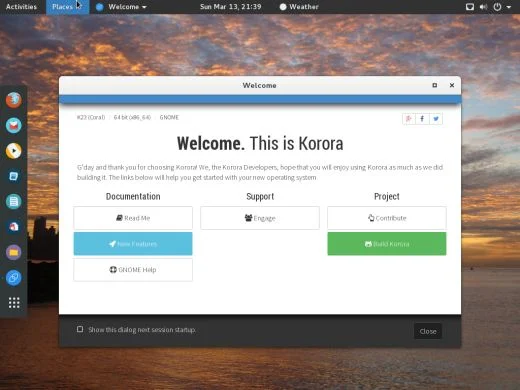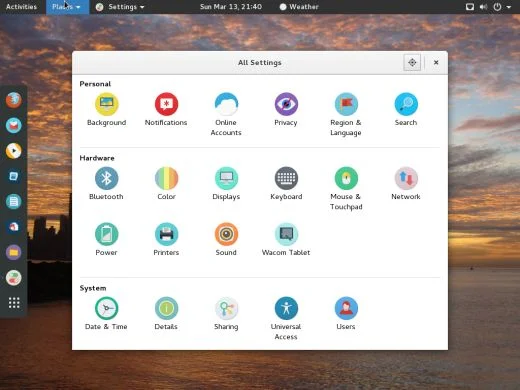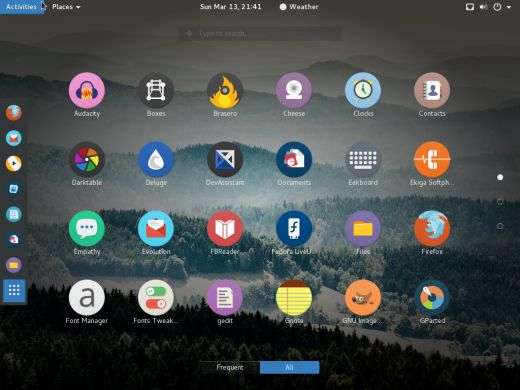Korora is Linux distribution that aims to make it easier to install and use for new Linux users, while still providing power-users with the tools and openness that they want. Originally, Korora was built on Gentoo, but in 2010, the team redid the whole thing as a Fedora Remix, with the goal of making the system "just work," from first boot. As a Remix, it ships Fedora packages, but also a number of things that Fedora cannot directly ship, including media codecs, graphics drivers, and other useful bits that may be in non-free repositories or require a lot of expertise to install and get breathing.
The Korora project has done something unusual in that they give not one or two choices of desktop, but five:
- Cinnamon
- Gnome
- KDE
- MATE
- Xfce
You can choose your platform (32- or 64-bit), and which desktop you want, and download an ISO file that is customized to that configuration. For my testing, I downloaded a 64-bit, Gnome install kit.
When I booted the ISO in a virtual machine, it booted swiftly to the desktop, and showed a dialog showing you could learn more about Korora, or install it to the hard drive. The toolbar on the left had commonly used apps in place, ready to go, including (to name a few) Firefox, LibreOffice, VLC Media Player, and Evolution. Although not the same set of choices I might make, they are good choices for most users, and you don't have to go through the business of installing them; things just work, from boot time.

The Korora Welcome screen, post-installation. On a live-booted ISO, there is an additional button to install to you local drive.
I chose to install Korora, rather than running as a live ISO, and the installation was quick and easy—confirm some choices about setup, timezone, and disk partitioning, and set your root password, and Korora does the rest. Each of the choices had extensive help, with good explanations of what the choices mean. On reboot, I was presented with more setup dialogues—keyboards, language choices, and the opportunity to connect online accounts from Google, ownCloud, Facebook, or Microsoft. After setting up a user account, you're ready to start using your new system! The layout of the screens will feel familiar to anyone who's been using recent releases of Android or OSX, with a "sea of icons" Applications menu and Settings screens.

Korora's Settings screen. I particularly like the three subdivisions of 'Personal', 'Hardware', and 'System'.
In exploring the Applications menu, I discovered that Samba is already installed, so integrating with a Microsoft network is relatively straightforward; I was able to coax it to see files on a Windows PC locally, as well as share files via Samba to the Windows PC. The Empathy messaging client is also a friendly choice, and setting up Jabber, IRC, and Facebook Chat for it took only minutes. Drivers for Wacom tablets come installed, so artists and other creative folk who use tablets will not have to suffer through extensive setup work. If your hardware is Bluetooth compliant, you're good to go there, as well. GIMP, Darktable, Handbrake, and other media tools are included, so you can get right to work with those tools, as well. The Software app lets you choose and install new applications from all the repositories in a familiar, comfortable app-store-like system, as well as handling uninstalls and updates.

This is the Applications menu's first page. Busy, yes, but not cluttery, with clear icons and text.
Is Korora the perfect one-size-fits-all Linux distro? Oh, by no means; Wine is not installed, so you're not going to run Windows apps in a Korora install without some work. Additionally, when users download the ISO, I'd like to see the documentation give the user help with choosing their desktop. I chose Gnome because I've used it before, but some sort of pros-and-cons statements might be useful for other users. Additionally, if you're looking for a server, you're at the wrong place. Korora is unashamedly geared toward desktops; MySQL, Apache and other server apps are not present in their software repositories. You could, of course, go add the needed repositories in /etc/yum.repos.d and go from there, but straight out of the box, this isn't a distribution for server operations.
Overall, if you need an easy-to-learn, easy-to-install operating system for a not-too-technical user, an artist, or even a developer who wants to get stuff done, take a look at Korora.







6 Comments